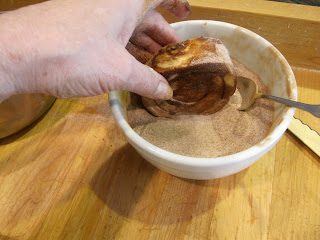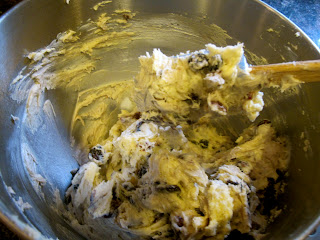Biscuits were one of my favorite quick breads that my mom made; fluffy and just waiting to be loaded up with butter and/or jam. My hubby had requested that I make the Amish Breakfast Casserole again this morning and instead of toast, I decided to make biscuits to go along with it.
A biscuit is a baked, floured-based product that has it's origins in Europe, but has a totally different form. The biscuits, found here in North America, are flaky and have more of a connection to a scone rather than the British version, which we would call a cookie.
My mother always made biscuits with buttermilk, which I also use, but I've changed and use butter rather than the shortening she would cut into the flour and I mix in two cups of grated cheese. Also, I brush my biscuit tops with a beaten egg and she usually brushed hers with melted butter. Finally, I leave space between my biscuits because I love that the sides brown too; typically biscuits are set side-by-side in a pan.
This recipe is easy to mix up (less than 15 minutes) and bakes in a hot oven in 13 to 15 minutes, so having a warm bread for breakfast is very do-able!
Cheesy Buttermilk Biscuits
3 1/2 + 1 T King Arthur all-purpose flour
2 T baking powder
1 tsp. sugar
1 1/2 tsp. salt
9 T cold unsalted butter (preferably European for a higher fat content), cut into small pieces
2 cups grated cheese
2 T chives, minced (optional)
1 3/4 buttermilk
1 egg, beaten to brush on top
Preheat oven to 425F-degrees. Line a baking sheet with parchment paper.
In a stand mixer, using the paddle attachment, mix the dry ingredients together. Add the chives, if using. While the mixer is running, add the small pieces of butter and mix until incorporated. You may have small pieces still visible. Add the cheese and then, while the mixer is running, slowly pour the buttermilk in. Mix only until incorporated!
Transfer the dough to a lightly floured bread board--it will look "shaggy."
Lightly dust the top of the dough with flour and knead just until the mixture comes together.
Lightly dust the top again, and roll dough to about 1-inch in thickness.
Now, the trick that my mother taught me and it is what makes beautiful, high biscuits...Lightly flour a biscuit cutter and press into the dough--DO NOT TWIST to release, but rather press and pull-up! I think of it as more a move Jack LaLaine would have done and not Chubby Checker:-D
Yes, that's the secret to high biscuits. If you twist, it "closes" the dough and keeps it from rising as high as it should!
Place biscuits onto the prepared sheet and brush tops with a beaten egg. Bake in the preheated oven 13 to 15 minutes, until golden brown.
Hmmm, warm flaky biscuits...does anybunny want some? Enjoy!
A biscuit is a baked, floured-based product that has it's origins in Europe, but has a totally different form. The biscuits, found here in North America, are flaky and have more of a connection to a scone rather than the British version, which we would call a cookie.
My mother always made biscuits with buttermilk, which I also use, but I've changed and use butter rather than the shortening she would cut into the flour and I mix in two cups of grated cheese. Also, I brush my biscuit tops with a beaten egg and she usually brushed hers with melted butter. Finally, I leave space between my biscuits because I love that the sides brown too; typically biscuits are set side-by-side in a pan.
This recipe is easy to mix up (less than 15 minutes) and bakes in a hot oven in 13 to 15 minutes, so having a warm bread for breakfast is very do-able!
Cheesy Buttermilk Biscuits
3 1/2 + 1 T King Arthur all-purpose flour
2 T baking powder
1 tsp. sugar
1 1/2 tsp. salt
9 T cold unsalted butter (preferably European for a higher fat content), cut into small pieces
2 cups grated cheese
2 T chives, minced (optional)
1 3/4 buttermilk
1 egg, beaten to brush on top
Preheat oven to 425F-degrees. Line a baking sheet with parchment paper.
In a stand mixer, using the paddle attachment, mix the dry ingredients together. Add the chives, if using. While the mixer is running, add the small pieces of butter and mix until incorporated. You may have small pieces still visible. Add the cheese and then, while the mixer is running, slowly pour the buttermilk in. Mix only until incorporated!
Transfer the dough to a lightly floured bread board--it will look "shaggy."
Lightly dust the top of the dough with flour and knead just until the mixture comes together.
Lightly dust the top again, and roll dough to about 1-inch in thickness.
Now, the trick that my mother taught me and it is what makes beautiful, high biscuits...Lightly flour a biscuit cutter and press into the dough--DO NOT TWIST to release, but rather press and pull-up! I think of it as more a move Jack LaLaine would have done and not Chubby Checker:-D
Yes, that's the secret to high biscuits. If you twist, it "closes" the dough and keeps it from rising as high as it should!
Place biscuits onto the prepared sheet and brush tops with a beaten egg. Bake in the preheated oven 13 to 15 minutes, until golden brown.
 |
| I add space between my biscuits! |
Hmmm, warm flaky biscuits...does anybunny want some? Enjoy!



























































